Turkeys are one of the must-have dishes that will always be included during Thanksgiving and Christmas celebrations. One can never speak of these festive holidays without mentioning some of the delicious recipes they have chosen to cook with their turkeys.
Aside from the delicious taste of turkey meat, it also contains more vitamins and minerals than any other type of meat.
If you are thinking of raising your own turkeys or simply looking for the ones that are raised commercially for their meat, this list will explain the 11 best turkey varieties you should definitely know.
1. The Bourbon Red
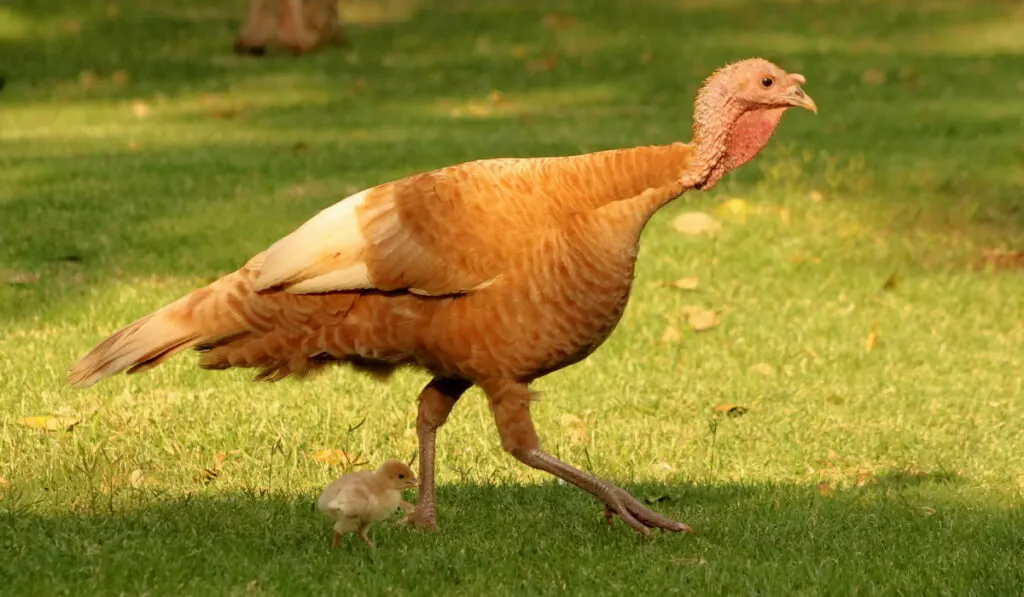
Named after Bourbon County in Kentucky’s Bluegrass region, the Bourbon Reds were originally developed in the 1800s by J.F. Barbee.
He crossed three different breeds; the Buff, the Bronze, and the White Holland turkeys, to produce high-quality, dark red turkeys with white wings and main tail feathers. These domestic turkeys were specifically bred for their meat.
The Bourbon Reds can be recognized by their dark red plumage, white wings, and tail feathers, chestnut neck, and chest with light buff under feathers. They also have beaks that are light horn color at the tip and dark at the base, and a red throat wattle that usually turns to bluish-white as they mature.
These turkeys can weigh up to 32 pounds with the hens weighing around 18 pounds.
Plucking the feathers to get the meat from Bourbon Reds is a bit hard but their meat is definitely delicious. Their carcass could weigh up to 23 pounds, which is quite heavy for most turkeys.
2. The Midget White
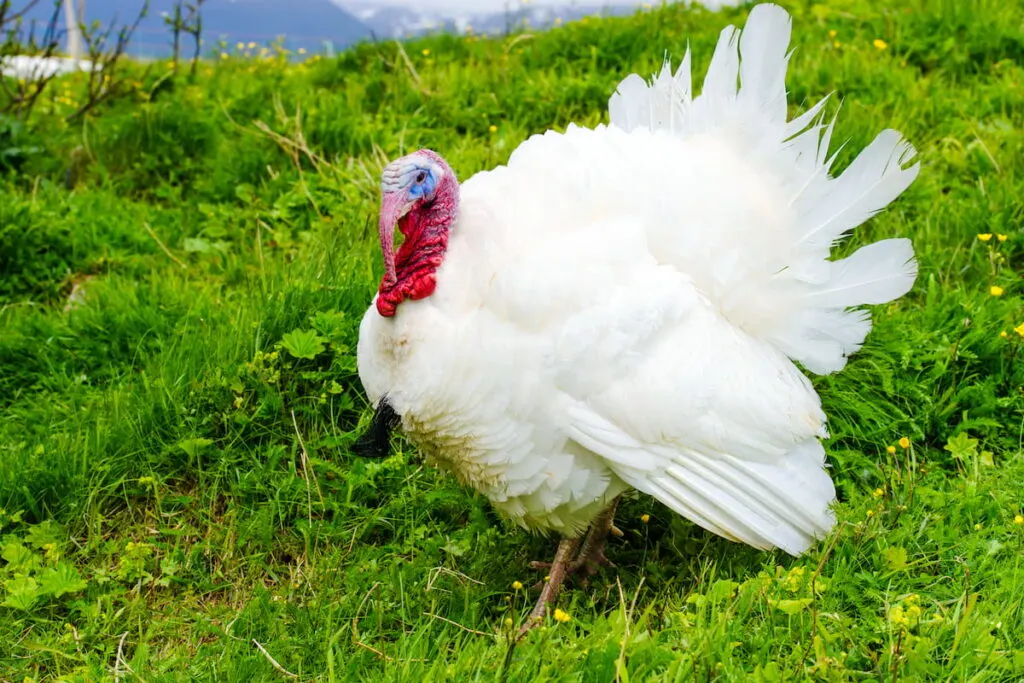
The Midget White turkeys are small, hardy birds that were originally developed by Dr. J. Robert Smyth at the University of Massachusetts in the 1960s.
This turkey variety was created by crossing a commercial Broad Breasted White turkeys with exhibition Royal Palm turkeys. Mainly bred and raised for their meat, these turkeys generally weigh around 10 to 12 pounds.
The Midget White turkeys possess white plumage and red throat wattles. The babies usually have dull yellow bodies with darker heads and orange beaks.
Keeping these turkeys grounded is one of the important things because they are able to fly when they are fully mature. Due to their friendly and approachable nature, they are also favored by anyone who is new to raising turkeys and homesteaders with a small farm.
3. The Broad Breasted White
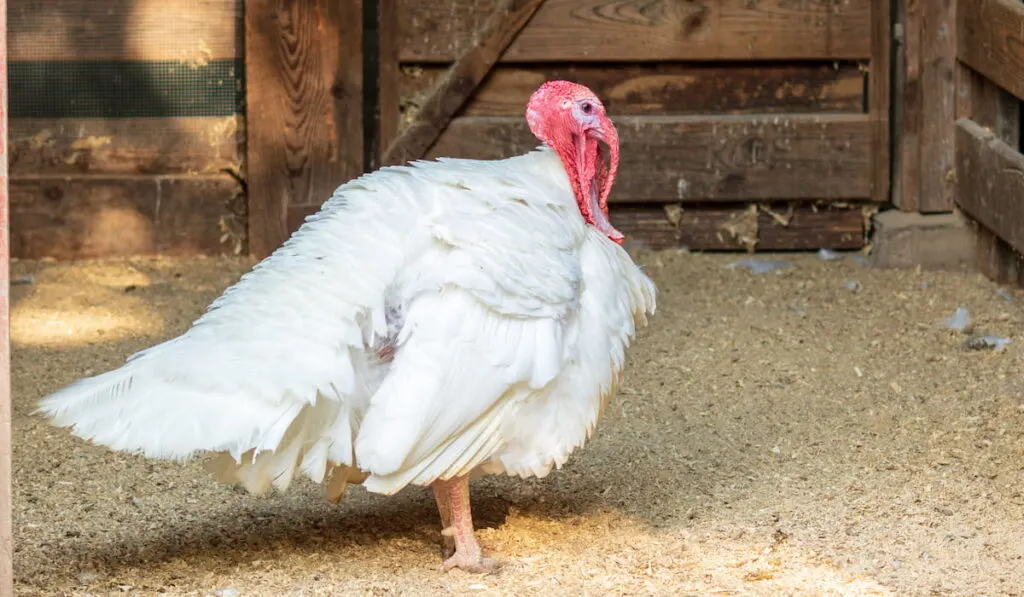
Being the most commonly used turkey for meat production, the Broad Breasted White turkeys are well-known by breeders and avid turkey lovers.
This breed was developed by crossing White Holland turkeys with Broad Breasted Bronze varieties. The toms of the Broad Breasted White could reach a weight of 50 pounds while the hens generally weigh between 25 and 30 pounds.
These turkeys can be recognized by their large bodies, white plumage, black beards, red throat wattles, and pink legs. Broad Breasted Whites are naturally docile.
But due to the males’ protective nature, they can get angsty when they are about to be butchered. Unlike other varieties that are also suitable for eggs production, these turkeys aren’t. Other than that, they are fast growers and usually favored for their delicious breast meats.
4. The Black Turkey
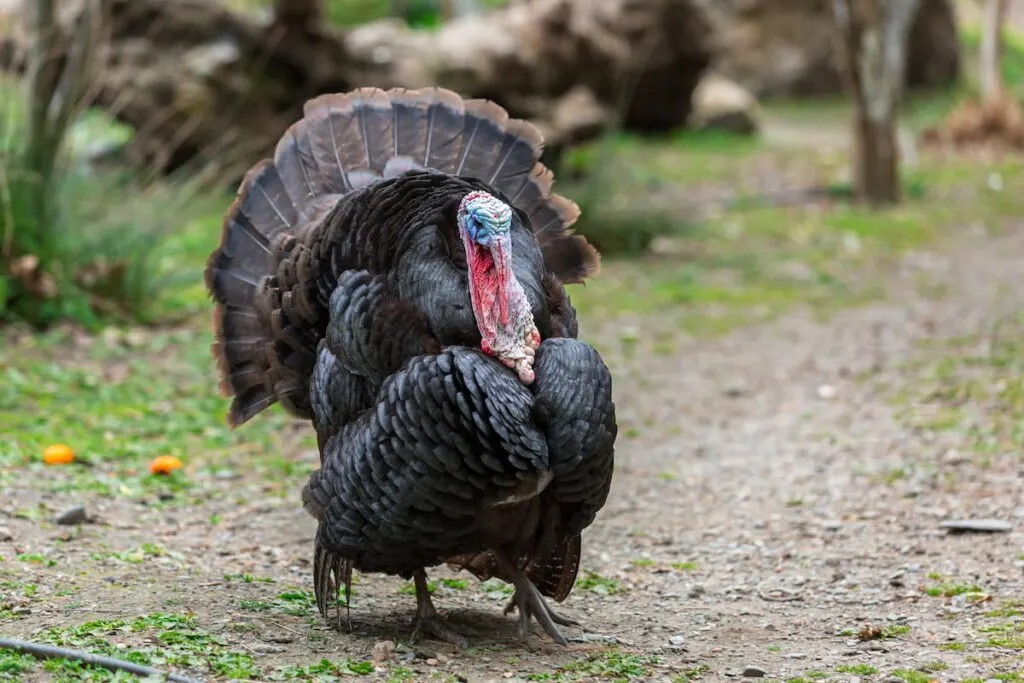
Also known as the ‘Black Spanish’ or the ‘Norfolk Black’, this turkey breed was developed in Europe by the Spanish explorers from Aztec turkeys that were brought from Mexico.
As they grew in popularity for meat production, these turkeys were brought to the United States by the European colonists. In 1874, they were recognized by the American Poultry Association as a breed.
Black turkeys generally weigh between 18 and 27 pounds. They have distinctive greenish-black plumage and pink to red throat wattles.
These medium-sized birds are the hardiest turkey breed with a docile temperament and exquisite meat taste. Raising this breed is fairly simple because of its adaptability in different types of climates.
5. The Beltsville Small White
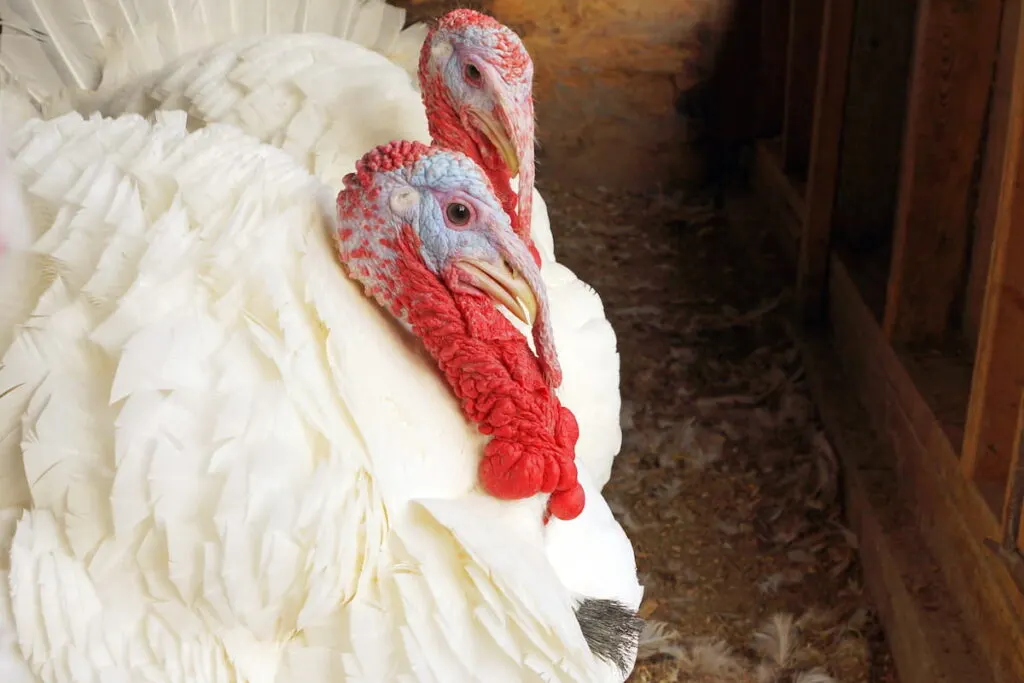
These turkeys were developed in 1941 by the Beltsville Agricultural Research Center (BARC) in Beltsville, Maryland.
In this breeding program, researchers crossed 5 different breeds to produce the Beltsville Small White turkeys. This includes the Narragansett, the Bronze, the White Holland, the White Austrian, and the wild turkey.
These turkeys are mainly bred for meat production. Although their population is critically low today, certain efforts have been made to preserve these turkeys from becoming extinct.
The Beltsville Small White turkeys can be recognized by their white plumage, red throat wattle, dark brown eyes, and pink toes. The toms generally weigh around 17 pounds while the hens only weigh around 10 pounds, which is slightly heavier than an average weight of a mature chicken.
These small-sized turkeys are docile and easy to handle. They can get along really well with other birds like chickens and ducks.
6. The Broad Breasted Bronze
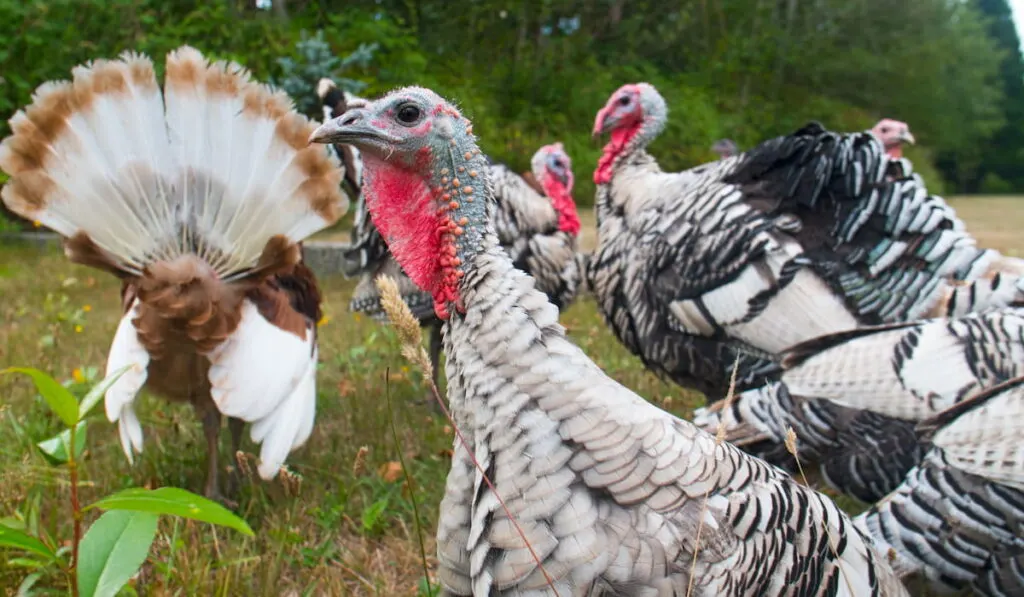
The Broad Breasted Bronze turkeys were first developed in the 18th century by crossing the domestic turkeys brought by the European colonists and the eastern wild turkeys found in America.
These large-sized hardy turkeys are bred for meat production and could yield a large amount of meat per serving. Breeding the Broad Breasted Bronze can be quite a hard task because of how large the males get.
The toms of the Broad Breasted Bronze turkeys generally weigh around 33 pounds while mature hens weigh around 23 pounds.
These turkeys can easily be recognized by their iridescent dark bronze plumage, red throat wattle, and white to bluish heads. They are mostly docile with humans but occasionally, their territorial instinct could make them turn aggressive and protective.
7. The Narragansett

The Narragansett turkeys received their name from their place of origin, which is Narragansett Bay in Rhode Island. They were developed by crossing wild eastern turkeys with the Norfolk Blacks.
In 1874, they were recognized by the American Poultry Association.
Raised for their meat, these turkeys can be recognized by the different color patterns on their plumage like black, tan, gray, and white. They also have white wing bars and a red to bluish-white throat wattle.
The toms of the Narragansett breed generally weigh around 30 pounds while the hens weigh around 18 pounds. The hens are also protective, nurturing, and considered great layers. The Narragansetts’ eggs are usually brown or spotted-tinted.
Raising this breed on a small farm is fairly easy due to their docile and easy-going temperament.
8. The White Holland
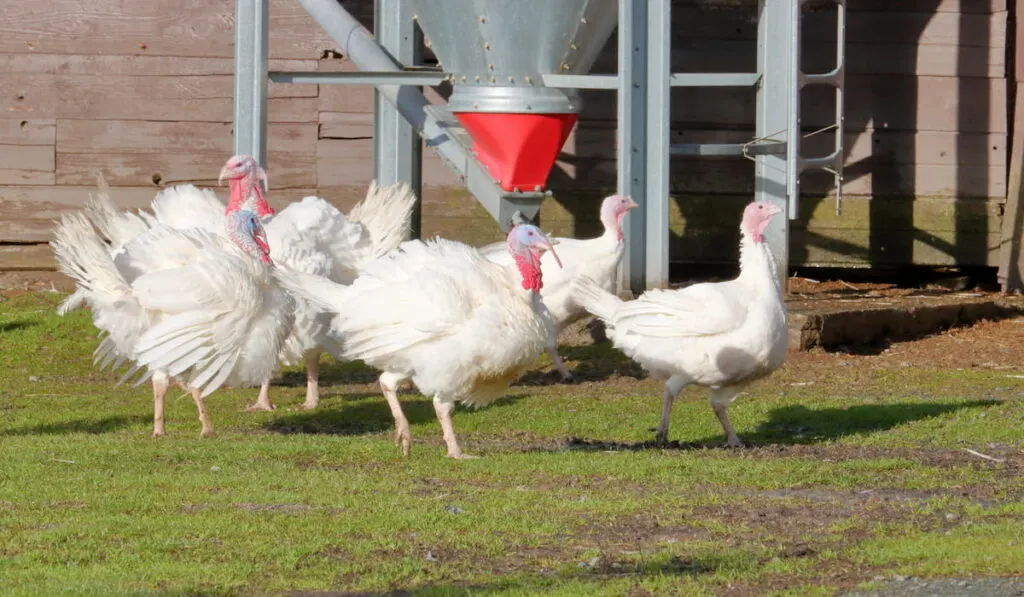
The White Holland turkeys originated in Mexico but were later redeveloped in Holland. They were born from the result of a crossbreeding between white European turkeys imported to North America and the native turkeys.
Considered as one of the rarest white turkeys, they were recognized by the American Poultry Association in 1874. These turkeys were also used as the base in creating Beltsville Small White turkeys.
From afar, they might look similar to the Broad Breasted White. But the White Holland turkeys tend to be smaller.
These turkeys can easily be recognized by their beautiful white plumage, red to bluish head, red throat wattle, black beard, and pink to horn color beaks.
The toms generally weigh around 33 pounds while the hens weigh around 18 pounds.
As a hardy breed, they are raised mainly for meat production. Today, these turkeys are quite rare and are often only seen in exhibitions.
9. The Blue Slate

Considered as a rare breed of heritage turkeys, the Blue Slate turkeys were named for their beautiful ashy blue plumage.
Although their origin is somewhat unclear, the most common theory that people share is that these turkeys came as a result of the cross of the Norfolk Black with the Spanish Black back in the 1800s.
Aside from their meat, they are also kept as pets and raised for poultry exhibitions. In 1874, they were recognized by the American Poultry Association as a breed.
The Blue Slate turkeys can be recognized by three-color variations; blue, solid blue, and solid black. Some spots can also be found on the blue variety. They also have heads that are red, with black beards, and beaks that are horn in color.
The toms of the Blue Slates generally weigh around 23 pounds while the hens weigh around 14 pounds.
These turkeys are great foragers and they make excellent backyard turkeys due to their docile and calm temperament.
10. The Chocolate Turkey
Like the color of their plumage, the Chocolate turkeys are one of the rare turkey breeds raised for their delicious meat.
Although their origin is somewhat vague, they were commonly found in the southern United States and France.
Due to the decline of their population before the Civil War, most of today’s Chocolate turkeys aren’t purebred. They carry genes from other breeds like the Narragansett, the Bourbon Red, and the Bronze.
The Chocolate turkeys possess brown plumage, milky brown shanks and legs, and a red throat wattle. The combination of black and brown genes is the main contributing factor to the color of their feathers.
The toms generally weigh around 33 pounds while the hens weigh around 18 pounds.
These hardy turkeys are also one of the larger varieties of heritage breeds. Raising Chocolate turkeys on small farms is fairly easy due to their docile and calm temperament.
11. The Jersey Buff
Also known as the Buff turkeys, this breed that is native to the mid-Atlantic region was named after their illustrious buff-colored feathers. In the late 1800s, the population of these turkeys declined because they were extensively used in the development of the Bourbon Red variety.
Although they were accepted by the American Poultry Association in 1874, the Bourbon Reds were still favored and caused more decline in the Buff turkeys’ population. However, in 1904, interest began to rise and people began to revive and preserve this breed.
The Buff turkeys possess a light to reddish-brown plumage, a red throat wattle, black beards, white tail feathers, and buff shading on their second under-feathers, with bluish-white shanks and toes.
The toms generally weigh around 21 pounds while mature hens weigh around 12 pounds.
Their docile and calm temperament makes them one of the best turkey breeds to be raised on a small farm. Although their population is pretty low, some breeders will raise these turkeys for their delicious meat.
Final Thoughts
No matter what variety they are, each of these turkey breeds provides a good amount of healthy and delicious meat that is commercially popular.
If you are thinking of raising one, the best option would be the fast growers and varieties that are easy to handle.
Citations
The Bourbon Red
- https://livestockconservancy.org/index.php/heritage/internal/bourbonred
- https://www.roysfarm.com/bourbon-red-turkey/
The Midget White
- https://www.roysfarm.com/midget-white-turkey/
- https://www.mcmurrayhatchery.com/midget_white_turkey_1.html
The Broad Breasted White
- https://morningchores.com/broad-breasted-white-turkeys/
- https://www.purelypoultry.com/broad-breasted-white-turkey-poults-p-462.html
The Black Turkey
- https://livestockconservancy.org/index.php/heritage/internal/blackturkey
- https://www.roysfarm.com/black-turkey/
The Beltsville Small White
- http://afs.okstate.edu/breeds/poultry/turkeys/beltsville-small-white/
- https://morningchores.com/beltsville-small-white-turkeys/
The Broad Breasted Bronze
- https://www.cacklehatchery.com/product/bronze-broad-breasted-turkey/
- https://www.roysfarm.com/bronze-turkey/
The Narragansett
- http://afs.okstate.edu/breeds/poultry/turkeys/narragansett/index.html/
- https://backyardpoultry.iamcountryside.com/poultry-101/narragansett-turkey-november-breed-of-the-month/
The White Holland
- https://www.myerspoultry.com/product-white-holland
- https://www.hobbyfarms.com/turkey-breeds-choose-turkey-farm/
The Blue Slate
- https://www.cacklehatchery.com/product/blue-slate-turkey/
- https://livestockconservancy.org/index.php/heritage/internal/slate
The Chocolate Turkey
- https://www.mcmurrayhatchery.com/chocolate_turkey.html
- https://livestockconservancy.org/index.php/heritage/internal/chocolate
The Jersey Buff
